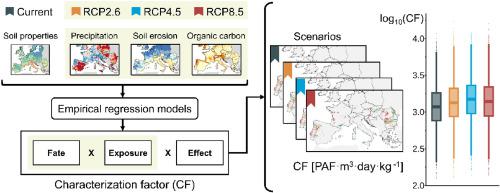Journal of Cleaner Production ( IF 9.7 ) Pub Date : 2023-05-28 , DOI: 10.1016/j.jclepro.2023.137601 Ivan Viveros Santos , Annie Levasseur , Cécile Bulle , Louise Deschênes , Anne-Marie Boulay

|
The use of copper-based preparations is a long-standing practice in viticulture to control vine fungal diseases, which has led to high copper concentrations in vineyard soils and impacts on off-target terrestrial organisms. Under projected climate change, some of the mechanisms and properties of soils that influence the extent of metals ecotoxicity impacts are projected to be altered, namely soil erosion, rainfall, temperature, and organic carbon content. In this context, and within the framework of life cycle assessment, this study aims to simulate the influence of projected changes in soil organic carbon, soil erosion, and rainfall on characterization factors (CFs) for copper terrestrial ecotoxicity across non-calcareous European vineyard soils. We employed empirical regression models to account for metal speciation and bioavailability as determined by soil characteristics. CFs were computed for a current scenario and mid-term future scenarios by 2050 determined across three Representative Concentration Pathways (RCP2.6, RCP4.5, and RCP8.5). Although future scenarios suggest that CFs may either increase or decrease, CFs are projected to increase for a larger share of the European vineyard surface, which may lead to higher terrestrial ecotoxicity impacts. The RCP4.5 scenario projects the highest increases in CFs, with a 27% rise in the median CF in comparison with the current scenario. Whereas the RCP8.5 and RCP2.6 scenarios project a 19% and 14% increase in median CFs, respectively. The changes in CFs were determined principally by the changes in copper bioavailability driven by projected changes in soil organic carbon. However, the spatial variability of CFs was larger than the temporal variation, with a variation of roughly 2 orders of magnitude across the analyzed scenarios. This study highlights the relevance of integrating spatial differentiation and the influence of projected climate change in the characterization modelling of copper terrestrial ecotoxicity.
中文翻译:

模拟气候变化对铜陆地生态毒性特征因素的影响
使用铜基制剂是葡萄栽培中控制葡萄真菌病害的长期做法,这导致葡萄园土壤中的铜浓度高,并对脱靶陆地生物产生影响。在预估的气候变化下,影响金属生态毒性影响程度的土壤的某些机制和特性预计会发生变化,即土壤侵蚀、降雨、温度和有机碳含量。在此背景下,在生命周期评估的框架内,本研究旨在模拟土壤有机碳、土壤侵蚀和降雨的预计变化对非石灰质欧洲葡萄园土壤铜陆地生态毒性特征因子 (CF) 的影响. 我们采用经验回归模型来解释由土壤特征决定的金属形态和生物利用度。CF 是针对当前情景和到 2050 年的中期未来情景计算的,这些情景在三个代表性浓度途径(RCP2.6、RCP4.5 和 RCP8.5)中确定。尽管未来情景表明 CF 可能会增加或减少,但预计 CF 会增加欧洲葡萄园面积的更大份额,这可能导致更高的陆地生态毒性影响。RCP4.5 情景预计 CF 增幅最高,与当前情景相比,CF 中值增长 27%。而 RCP8.5 和 RCP2.6 情景预计 CF 中值分别增加 19% 和 14%。CF 的变化主要是由土壤有机碳的预计变化所驱动的铜生物利用度的变化决定的。然而,CF 的空间变异性大于时间变异性,在分析的场景中变化大约为 2 个数量级。本研究强调了在铜陆地生态毒性表征模型中整合空间分异和预计气候变化影响的相关性。











































 京公网安备 11010802027423号
京公网安备 11010802027423号